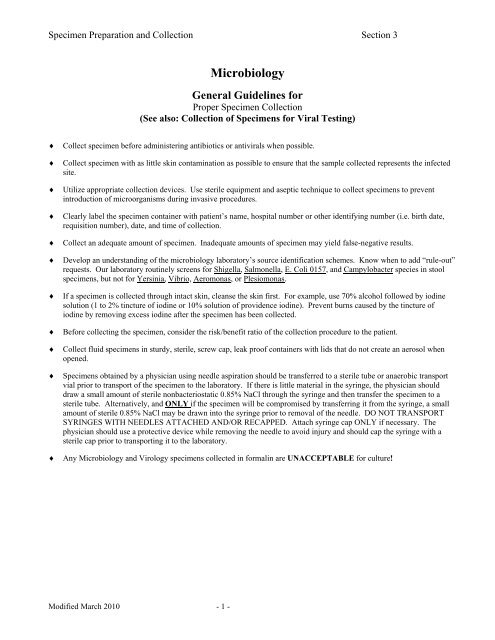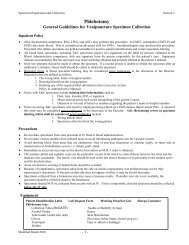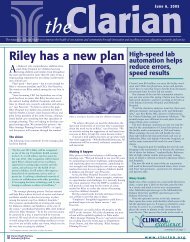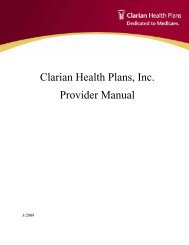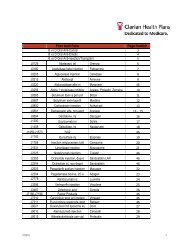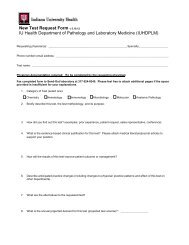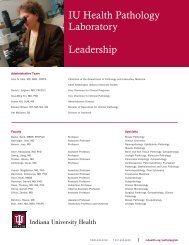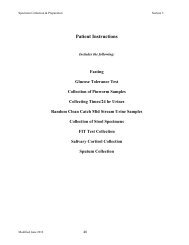Guidelines for Microbiology & Virology - IU Health
Guidelines for Microbiology & Virology - IU Health
Guidelines for Microbiology & Virology - IU Health
You also want an ePaper? Increase the reach of your titles
YUMPU automatically turns print PDFs into web optimized ePapers that Google loves.
Specimen Preparation and Collection Section 3<br />
<strong>Microbiology</strong><br />
General <strong>Guidelines</strong> <strong>for</strong><br />
Proper Specimen Collection<br />
(See also: Collection of Specimens <strong>for</strong> Viral Testing)<br />
♦<br />
♦<br />
♦<br />
♦<br />
♦<br />
♦<br />
♦<br />
♦<br />
♦<br />
♦<br />
♦<br />
Collect specimen be<strong>for</strong>e administering antibiotics or antivirals when possible.<br />
Collect specimen with as little skin contamination as possible to ensure that the sample collected represents the infected<br />
site.<br />
Utilize appropriate collection devices. Use sterile equipment and aseptic technique to collect specimens to prevent<br />
introduction of microorganisms during invasive procedures.<br />
Clearly label the specimen container with patient’s name, hospital number or other identifying number (i.e. birth date,<br />
requisition number), date, and time of collection.<br />
Collect an adequate amount of specimen. Inadequate amounts of specimen may yield false-negative results.<br />
Develop an understanding of the microbiology laboratory’s source identification schemes. Know when to add “rule-out”<br />
requests. Our laboratory routinely screens <strong>for</strong> Shigella, Salmonella, E. Coli 0157, and Campylobacter species in stool<br />
specimens, but not <strong>for</strong> Yersinia, Vibrio, Aeromonas, or Plesiomonas.<br />
If a specimen is collected through intact skin, cleanse the skin first. For example, use 70% alcohol followed by iodine<br />
solution (1 to 2% tincture of iodine or 10% solution of providence iodine). Prevent burns caused by the tincture of<br />
iodine by removing excess iodine after the specimen has been collected.<br />
Be<strong>for</strong>e collecting the specimen, consider the risk/benefit ratio of the collection procedure to the patient.<br />
Collect fluid specimens in sturdy, sterile, screw cap, leak proof containers with lids that do not create an aerosol when<br />
opened.<br />
Specimens obtained by a physician using needle aspiration should be transferred to a sterile tube or anaerobic transport<br />
vial prior to transport of the specimen to the laboratory. If there is little material in the syringe, the physician should<br />
draw a small amount of sterile nonbacteriostatic 0.85% NaCl through the syringe and then transfer the specimen to a<br />
sterile tube. Alternatively, and ONLY if the specimen will be compromised by transferring it from the syringe, a small<br />
amount of sterile 0.85% NaCl may be drawn into the syringe prior to removal of the needle. DO NOT TRANSPORT<br />
SYRINGES WITH NEEDLES ATTACHED AND/OR RECAPPED. Attach syringe cap ONLY if necessary. The<br />
physician should use a protective device while removing the needle to avoid injury and should cap the syringe with a<br />
sterile cap prior to transporting it to the laboratory.<br />
Any <strong>Microbiology</strong> and <strong>Virology</strong> specimens collected in <strong>for</strong>malin are UNACCEPTABLE <strong>for</strong> culture!<br />
Modified March 2010 - 1 -
Specimen Preparation and Collection Section 3<br />
General <strong>Guidelines</strong> <strong>for</strong><br />
Transport of <strong>Microbiology</strong> Specimens<br />
(See also: Collection of Specimens <strong>for</strong> Viral Testing)<br />
♦<br />
♦<br />
Transport all specimens to the laboratory promptly.<br />
1. To ensure the survival and isolation of fastidious organisms and to prevent overgrowth by more hardy bacteria.<br />
2. To shorten the duration of specimen contact with some local anesthetics used in the collection procedure that may<br />
have antibacterial activity.<br />
3. To provide a more accurate diagnosis of the infectious disease process.<br />
4. All collections must be labeled with correct date and time of collection and the specific site.<br />
Alternatives to prompt delivery<br />
1. Refrigerate most specimens as 2° – 8° C. The following are exceptions:<br />
a. Blood cultured in Bactec bottles must be kept at room temperature or incubated at 35° - 37° no longer than<br />
20 hours. An ISOLATOR tube is held at room temperature. Blood <strong>for</strong> viral culture MUST be held at room<br />
temperature and transported within 6 hours of collection.<br />
b. Specimens may harbor temperature sensitive organisms and should be left at room temperature.<br />
Exception: urines in non-preservative transport containers should be refrigerated.<br />
c. An anaerobic transport system MUST be used <strong>for</strong> anaerobic culture requests.<br />
d. Stool specimens should be collected in STOOL transport vials. See following tables. Diapers and swabs are NOT<br />
ACCEPTABLE <strong>for</strong> parasite determinations.<br />
e. In general, spinal fluid (CSF) specimens are held at room temperature. Alternatively, incubate at 35 - 37 C.<br />
CSF <strong>for</strong> viral culture should be refrigerated.<br />
2. Use of specimen transport systems:<br />
a. Anaerobic transport systems are used to ensure the viability of anaerobic organisms in transit to the laboratory.<br />
See Table 1.<br />
b. Aerobic transport methods are listed in Table 2. Although sterile swabs can be used <strong>for</strong> collection and transport<br />
of specimens, the test request should be considered prior to specimen collection. Certain types of swabs should<br />
be used <strong>for</strong> collection and transport of certain cultures, as described in Table 2.<br />
c. Specific transport containers <strong>for</strong> specimens are listed in Table 3.<br />
Port-a-Cult Tube<br />
System<br />
TABLE 1. ANAEROBIC TRANSPORT SYSTEMS<br />
Description<br />
Tube is used <strong>for</strong> transporting swabs. Contains a semi-solid medium with<br />
reducing agent and redox indicator. Any purple discoloration of medium<br />
indicates exposure to air. Viability of anaerobes, facultative and aerobic<br />
organisms are maintained <strong>for</strong> up to 72 hours at 20-25 o C. This tube should<br />
not be used to transport small volumes of body fluids, aspirates or tissues.<br />
Syringe/Needle Aspirates<br />
Bactec Blood Bottles<br />
Sterile Screw Cap Containers<br />
Express air from syringe, remove needle, and recap with syringe cap.<br />
Small amounts of fluid may be transferred to a vacutainer red top tube <strong>for</strong><br />
transportation. If fairly large volume (5 ml or more), anaerobic bacteria<br />
will survive <strong>for</strong> 24 hours at room temperature. See specimen collection<br />
guidelines <strong>for</strong> physician collection of syringe aspirates.<br />
Fluids collected in large quantities >10 mL may be directly inoculated<br />
into Bactec blood culture vials; 8-10 ml in each bottle (aerobic and<br />
anaerobic). Transport immediately at room temperature. Alternatively,<br />
incubate at 35-37. If Bactec bottles are used, 1 mL of fluid in a red top<br />
vacutainer should also be sent.<br />
These are best <strong>for</strong> transporting tissue and biopsy specimens. If specimen<br />
is small, place on sterile gauze moistened with sterile non-bacteriostatic<br />
0.85% NaCl. Do not wrap in gauze. DO NOT USE FORMALIN<br />
Modified March 2010 - 2 -
Specimen Preparation and Collection Section 3<br />
TABLE 2. AEROBIC TRANSPORT SYSTEMS<br />
System<br />
Description/Comments<br />
Sterile, disposable culture collection and transport system consisting of a<br />
Culturette Swab (Stuart’s Media) plastic tube containing a rayon-tipped swab and transport medium to<br />
prevent drying of bacteria and maintain pH<br />
Residual fatty acids may inhibit MRSA, Group B Beta Strep and Chlamydia<br />
sp. If cotton is glued or spun to wooden applicator stick, wooden stick may<br />
Cotton Swabs<br />
inactivate viruses and interfere with some Ureaplasma identification tests.<br />
(Cotton Swabs are NOT<br />
There<strong>for</strong>e; wooden shafted swabs are UNACCEPTABLE FOR MRSA,<br />
recommended <strong>for</strong> use)<br />
Group BBS, Chlamydia, Ureaplasma and VIRAL CULTURE. Calgiswab® a<br />
also unacceptable <strong>for</strong> viral culture.<br />
Nasopharyngeal/ Mini-tip<br />
Culturettes<br />
Sterile Screw-cap Containers<br />
Sterile Petri Dishes<br />
Sterile Tubes: Screw-cap Glass or<br />
Plastic tubes, Sterile Vacutainer Tubes<br />
without additives<br />
B-D Urine Tubes<br />
Ova & Parasite Vials<br />
M4 RT Tube (red capped)<br />
M4 Tube (blue capped)<br />
GenProbe Aptima Tubes<br />
Flexible wire shafts with small rayon tips provide <strong>for</strong> easier urethrogenital,<br />
and nasopharyngeal specimens collection or culture of B. pertussis,<br />
N. gonorrhoeae and respiration virus in children.<br />
Useful <strong>for</strong> collection of urine, sputum, stool, Bronchoalveolar Lavage,<br />
catheter tips and specimens <strong>for</strong> routine and viral cultures. For small specimen<br />
place on sterile gauze moistened with sterile nonbacteriostatic 0.85 % NaCl<br />
in a cup NEVER place biopsy specimen in <strong>for</strong>malin or wrap in gauze.<br />
Useful <strong>for</strong> hair or skin-scraping specimens. Tape petri dish securely prior<br />
to transport.<br />
Useful <strong>for</strong> collection of sterile fluids, drainage, or bronchial brush<br />
specimens <strong>for</strong> routine bacterial, viral, or chlamydial culture. These tubes<br />
are NOT to be used <strong>for</strong> transport of anaerobic specimens.<br />
Vacutainer tube containing 0.5 ml freeze-dried boric acid- sodium<br />
<strong>for</strong>mate maintenance <strong>for</strong>mula. Maintenance <strong>for</strong>mula holds bacterial<br />
population in urine specimen <strong>for</strong> 48 hours at room temperature comparable<br />
to those in urine specimens without additives, but held under refrigeration<br />
<strong>for</strong> the same period. Preservative may be toxic to some uropathogens.<br />
UNACCEPTABLE <strong>for</strong> Virus culture, Legionella antigen or Histoplasmosis<br />
antigen testing.<br />
Two (3) container package: one PVA, one <strong>for</strong>mal in to preserve<br />
feces <strong>for</strong> parasite detection, and one has Carey Blair media <strong>for</strong> stool culture.<br />
Preservative containers are unacceptable <strong>for</strong> other stool tests. ALWAYS<br />
inoculate all three vials.<br />
Sterile swabs and transport tubes containing Hanks BSS, antibiotics and<br />
fungizone. Suitable <strong>for</strong> Chlamydia Trachomatis PCR, GC PCR,<br />
C. Trachomatis and Chlamydia Respiratory Culture. Once inoculated,<br />
store refrigerated until it is to be transported.<br />
Use sterile transport tubes containing Hanks BSS, antibiotics and<br />
fungizone. For collection and transport of Mycoplasma and Ureaplasma<br />
cultures only. Once inoculated, store refrigerated until it is to be transported.<br />
Use with the Aptima Systems ONLY. Good <strong>for</strong> detecting C. Trachomatis and<br />
Gonorrhoeae by PCR. UNACCEPTABLE <strong>for</strong> other testing including C.<br />
Trachomatis and N. Gonorrhoeae culture.<br />
Viral Transport Medium<br />
Blood<br />
*See also Collection of Specimens <strong>for</strong> Viral Testing<br />
Bactec system <strong>for</strong> routine blood culture and isolator system if systemic<br />
yeast and mycobacteria are suspected. Yellow (ACD) or Green (Lithium<br />
or Sodium Heparin) top tube <strong>for</strong> virus isolation.<br />
Modified March 2010 - 3 -
Specimen Preparation and Collection Section 3<br />
TABLE 3. SPECIMEN TRANSPORT GUIDE<br />
Source and type of specimen<br />
CNS<br />
CSF<br />
Brain abscess<br />
CNS Biopsy<br />
Gastrointestinal system<br />
Stool<br />
Rectal Swab<br />
Gastric lavage/washings<br />
Duodenal aspirate<br />
Rectal biopsy<br />
Sigmoidoscopy specimen<br />
Eye<br />
Conjunctiva scrapings<br />
Corneal scrapings<br />
Intraocular fluid<br />
Genital Tract, Female<br />
Amniotic fluid<br />
Fallopian tube<br />
Bartholin fluid<br />
Endometrial<br />
Vulval<br />
Cervical<br />
Urethral<br />
Vaginal<br />
Genital tract, Male<br />
Anal swab<br />
Urethral<br />
Epididymis<br />
Prostatic massage<br />
Semen<br />
Penile lesion<br />
Transport Method<br />
Sterile screw-cap tube<br />
Anaerobic transport system<br />
If swab submitted, send in anaerobic transport system. If specimen is<br />
tissue, send in sterile cup with small amount of nonbacteriostatic<br />
0.85% NaCl, (NEVER place in <strong>for</strong>malin.)<br />
Sterile screw-cap cup and/or Ova & Parasite Vials.<br />
Culturette (<strong>for</strong> pinworm, use pinworm collection kit.)<br />
Sterile screw-cap cup or sputum trap<br />
Sterile screw-cap cup or sputum trap<br />
Sterile screw-cap cup. If specimen is small, send in sterile cup with small<br />
amount of nonbacteriostatic 0.85% NaCl. (NEVER place in <strong>for</strong>malin.)<br />
Sterile screw-cap cup. If specimen is small, send in sterile cup with small<br />
amount of nonbacteriostatic 0.85% NaCl. (NEVER place in <strong>for</strong>malin.)<br />
Culturette<br />
Send prepared smears and/or directly plated media.<br />
Send prepared smears and/or directly plated media.<br />
Send prepared smears and/or directly plated media, capped syringe without<br />
needle with air expelled or sterile tube.<br />
1 - 2 ml of sample in sterile screw-cap tube. Amounts greater than 2 ml<br />
may be directly inoculated into blood culture vials. Do not refrigerate.<br />
1 - 2 ml of sample in sterile screw-cap tube or anaerobic transport system.<br />
1 - 2 ml of sample in sterile screw-cap tube or anaerobic transport system.<br />
Sterile screw-cap cup or tube or anaerobic transport system.<br />
Capped syringe without needle, culturette, viral culturette, or M4RT tube<br />
<strong>for</strong> Chlamydial transport.<br />
Culturette, viral culturette, M4RT tube, female GenProbe specimen<br />
collection kit, M4 tube.<br />
Culturette, viral culturette, M4RT tube, M4 tube.<br />
Culturette, viral culturette, M4RT tube, M4 tube.<br />
Culturette, viral culturette, M4RT tube.<br />
Mini-tip culturette, viral culturette, M4RT tube, male GenProbe specimen<br />
collection kit, M4 tube.<br />
Sterile screw-cap cup or anaerobic transport system.<br />
Sterile screw-cap tube, or cup or culturette.<br />
Sterile screw-cap tube, or cup or culturette, M4 tube<br />
Capped syringe without needle, culturette, viral culturette, M4RT tube.<br />
Modified March 2010 - 4 -
Specimen Preparation and Collection Section 3<br />
Source and type of specimen<br />
Lower respiratory tract<br />
Lung biopsy<br />
Induced sputum/Expectorated Sputum<br />
Tracheal/endotracheal aspirate<br />
Bronchoalveolar Lavage<br />
Bronchial washings<br />
Transbronchial biopsy<br />
Bronchial brush<br />
Transtracheal aspirate<br />
Lung aspirate<br />
Upper respiratory tract<br />
Throat swab<br />
Nasal swab<br />
Oral culture<br />
Nasopharyngeal swab<br />
Tympanocentesis fluid<br />
Sinus aspirate<br />
Nasopharyngeal suction<br />
Nasal washings<br />
Sterile body fluids:<br />
(excluding: CSF, urine, blood)<br />
Pleural, peritoneal, ascites, joint and<br />
synovial fluid.<br />
Subcutaneous tissue and skin<br />
Ulcers or nodules, superficial wounds,<br />
Exudates<br />
Biopsy<br />
Burn specimens<br />
Superficial fungal lesion<br />
Deep wounds, aspirates, tissues<br />
Site wounds, swabs<br />
Deep wounds, abscesses<br />
Soft tissue aspirates<br />
Bone<br />
Punch skin biopsy, tissue<br />
Urine<br />
Clean catch (CCMS)<br />
Ileal loop<br />
Straight catheter<br />
Suprapubic aspirate<br />
Bladder washout<br />
Bilateral urethral catheterization<br />
TABLE 3. SPECIMEN TRANSPORT GUIDE – con’t<br />
Transport Method<br />
Sterile screw-cap cup; if specimen is small, place it in a small amount of<br />
nonbacteriostatic 0.85 % NaCl. (NEVER place in <strong>for</strong>malin.)<br />
Sterile screw-cap cup.<br />
Sterile screw-cap cup or sputum trap<br />
Sputum trap or sterile screw-cap cup<br />
Sputum trap or sterile screw-cap cup<br />
Sterile screw-cap cup with 1 - 2 ml nonbacteriostatic 0.85 % NaCl.<br />
Sterile screw-cap tube.<br />
Sterile screw-cap cup or tube, or anaerobic transport system.<br />
Sterile screw-cap cup or tube, or anaerobic transport system.<br />
Culturette or viral transport system.<br />
Culturette or viral transport system.<br />
Culturette or viral transport system (HSV).<br />
Mini-tip culturette, viral transport system or Starswab II/Amies charcoal<br />
media<br />
Anaerobic transport system or capped syringe without needle.<br />
Anaerobic transport system or capped syringe without needle.<br />
Sterile screw-cap cup or viral transport system.<br />
Sterile screw-cap cup or viral transport system.<br />
Sterile screw-cap container, capped syringe without needle, anaerobic<br />
transport system, red top vacutainer tube. Volumes greater than 10 ml may<br />
be inoculated directly into blood culture vials along with specimen in<br />
red top vacutainer tube.<br />
Capped syringe without needle.<br />
Sterile screw-cap cup; if specimen is small, add a small amount of sterile<br />
nonbacteriostatic 0.85 % NaCl to prevent drying.<br />
Sterile screw-cap container.<br />
Sterile screw-cap container<br />
Anaerobic transport system.<br />
Sterile screw-cap container or anaerobic transport system.<br />
Capped syringe without needle.<br />
Sterile screw-cap container; if specimen is small, add a small amount of<br />
sterile nonbacteriostatic 0.85 % NaCl to prevent drying.<br />
Sterile screw-cap container; if specimen is small, add a small amount of<br />
sterile nonbacteriostatic 0.85 % NaCl to prevent drying.<br />
B-D vacutainer or sterile screw-cap container.<br />
B-D vacutainer or sterile screw-cap container.<br />
B-D vacutainer or sterile screw-cap container.<br />
Capped syringe without needle or anaerobic transport system.<br />
Sterile screw-cap container. Label with correct times and sites<br />
Sterile screw-cap container. Label with correct times and sites.<br />
Modified March 2010 - 5 -
Specimen Preparation and Collection Section 3<br />
General <strong>Guidelines</strong> <strong>for</strong><br />
Blood Culture Collection<br />
TABLE 4: Recommendations <strong>for</strong> Blood Culture Collection<br />
Clinical Condition Collection Protocol Comments<br />
For Adults/Adolescents<br />
Severe Septicemia (2) Cultures prior to therapy One (1) 10-15 ML sample from each arm<br />
Acute Endocarditis<br />
(2) Cultures w/in 1-2 hr. of Space each collection at least 1 hr. apart with two<br />
Subacute endocarditis<br />
Low grade intravascular<br />
infection<br />
Bacteremia of unknown origin<br />
Patient on therapy<br />
evaluation and prior to therapy<br />
(2) Cultures w/in 24 hr. on<br />
day (1). If negative 24 hr. later,<br />
obtain (2) more<br />
(2) separate venipunctures<br />
Space each collection at least 1 hr. apart. Patients<br />
receiving antibiotics prior to admission, obtain two<br />
(2)separate cultures on each of three (3) successive<br />
days. Cultures should be incubated at least (14) days.<br />
*NOTE: contact the microbiology lab when cultures<br />
need to be held longer than (5) days.<br />
(2) Cultures w/in 24 hr. Specimens should be collected at Least 1 hr. apart<br />
at first sign of febrile episodes.<br />
(4) Cultures w/in 48 hr. Take specimen immediately prior to next dose of<br />
antibiotic. Cultures should be incubated <strong>for</strong> at<br />
least (14) days *NOTE: contact the microbiology<br />
lab when cultures need to be held longer than (5) days<br />
Febrile Episodes<br />
No more than two (2) total<br />
cultures<br />
Bacteremia may precede episodes of fever and<br />
chills by about one (1) hr.<br />
Small Children (< 4 years) 1-2 ML. samples (2) Cultures usually suffice <strong>for</strong> diagnosing bacteremia<br />
in the newborn. Less than 1 mL of blood will detect<br />
Bacteremia when concentration of organism is<br />
sufficiently high. If so, inoculate (1)Peds Plus bottle.<br />
♦<br />
♦<br />
♦<br />
♦<br />
♦<br />
♦<br />
♦<br />
♦<br />
♦<br />
♦<br />
♦<br />
The volume of blood <strong>for</strong> culture is critical! Concentration of organisms in most cases of Bacteremia is low, especially<br />
if the patient is on antimicrobial therapy.<br />
Most cases of Bacteremia are detected using 2 sets of separately collected blood cultures. More that 2 sets yield little<br />
additional in<strong>for</strong>mation.<br />
In children less than four, the concentration of organisms during bacteremia is higher than those four years and older;<br />
there<strong>for</strong>e, less blood is acceptable <strong>for</strong> culture utilizing the Peds Plus bottles.<br />
The yield of blood cultures in adults increases approximately 3% per ml of blood cultured. Culture bottles with<br />
inadequate blood volumes may demonstrate no growth when in fact microorganisms are present in the blood. To<br />
accurately ascertain bacteremic episodes and obtain the best sensitivity, the maximum amounts of blood (specified on<br />
the collection bottles) should be obtained <strong>for</strong> culture.<br />
One blood culture “set” is defined as a sample of blood drawn at a single time at a single site, regardless of how many<br />
bottles are injected into. These “sets” typically should be collected ten minutes apart unless ordered otherwise. For<br />
blood cultures obtained from an intravascular line it is permissible to obtain both “sets” with one large volume draw.<br />
Ideally blood cultures are obtained from peripheral venipuncture (i.e. - two sets from two separate venipunctures).<br />
Draw blood cultures prior to initiating or changing antimicrobial therapy if at all possible.<br />
Aseptic technique is critical to obtaining accurate results. When obtaining specimens via skin puncture, a second person<br />
may be needed to assist in extremity stabilization and to place blood into bottles while pressure is held over puncture site.<br />
Inpatient Collection Policy<br />
RN’s, LPN’s, AST’s, house staff or physicians who have received competency validation in blood culture specimen<br />
collection may draw Blood cultures.<br />
A physician’s order is required to obtain blood cultures from an intravascular line. It is critical to label the specimen with<br />
the specific line it is drawn from (eg - arterial, PICC, etc.).<br />
Blood can be collected from veins, arteries, or intravascular catheters<br />
Modified March 2010 - 6 -
Specimen Preparation and Collection Section 3<br />
Collection Guideline<br />
Volume of Blood <strong>for</strong> Collection<br />
“ADULT BLOOD/PER STICK”(a, b)<br />
(> 4 years old)<br />
Peripheral<br />
Vascular Catheter (b, c)<br />
20 mL<br />
< 20 mL<br />
< 10 mL 20-30 mL 10-20 mL<br />
< 10 mL<br />
10 mL<br />
AER<br />
10 mL<br />
ANA<br />
3-10 mL<br />
AER<br />
ONLY<br />
Specimen Preparation and Collection Section 3<br />
♦<br />
♦<br />
Blood <strong>for</strong> CMV/Adenovirus/Herpes (HSV) cultures:<br />
1. Blood <strong>for</strong> viral culture is ONLY processed Monday - Friday, 7 AM to 1 PM, Saturday if received in lab by 8 AM.<br />
2. Blood MUST BE in the laboratory within 6 Hours of collection<br />
3. DO NOT REFRIGERATE! STORE AT ROOM TEMPERATURE.<br />
If viremia, fungemia, brucellosis, tularemia, bartonella, or an infection with a cell-wall deficient or fastidious bacterium<br />
is suspected, the microbiology laboratory should be contacted <strong>for</strong> special instructions.<br />
Equipment<br />
Alcohol Swabs Appropriate Blood Culture Bottles 10 - 30 ml syringe Exam Gloves<br />
Tincture of Iodine Sepp Needle/Butterfly <strong>for</strong> Venipuncture NICU: Providone-iodine<br />
Procedure (Observe Universal {Standard} Precautions):<br />
♦ Put on gloves (clean exam gloves are acceptable).<br />
♦ Disinfect the septa of the blood culture bottles utilizing 70% isopropyl alcohol. NOTE: Do not use iodine/providenceiodine<br />
to prevent septa from deteriorating.<br />
♦ Identify site <strong>for</strong> specimen collection.<br />
♦<br />
♦<br />
♦<br />
TABLE 5. Media <strong>for</strong> isolation of organisms from Blood Culture Media.<br />
CULTURE MEDIA TYPE AMOUNT OF BLOOD<br />
Bacteria/Yeast<br />
Bactec 26 Plus (Silver Label) or<br />
Bactec Peds Plus (Pink Label)<br />
Anaerobes Bactec Lytic (Purple Label) 3 – 10 ML<br />
Systemic Fungus (Histoplasma Capsulatum Adult Isolator<br />
or Cryptococcus Neo<strong>for</strong>mans) Pediatric Isolator<br />
Mycobacteria Adult Isolator 9 – 10 ML<br />
CMV/Adenovirus/HSV<br />
ACD (Yellow Top), EDTA (Purple)<br />
Heparin (Green Top: sodium or lithium))<br />
8 – 10 ML Adults<br />
0.5 – 5 ML Peds<br />
9 – 10 ML Adults<br />
0.5 – 1.5 ML Peds<br />
8 – 10 ML Adults<br />
3 ML Peds<br />
Peripheral Venipuncture/Arterial Puncture:<br />
1. Vigorously cleanse site by rubbing in concentric circles with 70% isopropyl alcohol to disinfect the skin.<br />
2. Vigorously disinfect the site by starting at the center and rub in concentric circles utilizing tincture of iodine<br />
solution <strong>for</strong> one-two minute duration. NOTE: NICU utilize betadine. For iodine sensitive patients, utilize 70%<br />
isopropyl alcohol <strong>for</strong> one-two minute duration.<br />
3. Allow the disinfectant to dry (iodine and alcohol function by drying). NOTE: Do not palpate over the site the needle<br />
will enter once the site is disinfected (to decrease contamination risk to the specimen).<br />
4. Draw blood via a syringe and needle/butterfly.<br />
5. Remove needle/butterfly and apply pressure to site until bleeding stops.<br />
6. Place blood into appropriate collection bottles/tubes. Inoculate aerobic bottle first. Refer to collection diagram. It is not<br />
necessary to change needles prior to inoculating bottles/tubes.<br />
7. If septum becomes contaminated with blood, clean with 70% isopropyl alcohol.<br />
8. Once hemostasis is obtained at puncture site, cleanse residual iodine/betadine from site with alcohol to prevent skin<br />
irritation.<br />
Line Draws<br />
1. If more than one intravascular catheter is available to obtain blood then select line least likely to be<br />
colonized/contaminated with microorganisms. Most typically it should be the newest line in; however, consider<br />
factors such as breaks into the line <strong>for</strong> blood draws, tubing changes or catheter manipulations.<br />
2. Cleanse line adapter, as needed, if one is present, vigorously with 70% isopropyl alcohol prior to obtaining<br />
specimen.<br />
3. Follow “Collection Diagram” <strong>for</strong> placing blood specimen into bottles. Inoculate aerobic bottle first.<br />
Specimen Labeling<br />
1. Label each bottle with patient label containing name and hospital number. Include date, time, specific line site if line<br />
draw, Accudata/I-Stat code or name of person collecting specimen.<br />
2. DO NOT COVER BAR CODE OF BOTTLE WITH LABEL!!!<br />
Modified March 2010 - 8 -
Specimen Preparation and Collection Section 3<br />
General <strong>Guidelines</strong> <strong>for</strong><br />
Sterile Body Fluids Collection<br />
(excluding CSF, urine, and blood)<br />
♦<br />
♦<br />
Clean the needle puncture site with alcohol, and disinfect it with an iodine solution to prevent introduction of<br />
infection. (If tincture of iodine is used, remove with 70 % isopropyl alcohol after the procedure to avoid burns.)<br />
Expel any air bubbles from the syringe, and immediately inject the specimen into a sterile screw-cap container. If<br />
sufficient fluid (10 - 20 ml), inject fluid into blood BACTEC bottles; also send fluid in a red vacutainer tube <strong>for</strong> stains<br />
and direct culture. The specimen may be sent in the syringe with the needle removed.<br />
TABLE 6. Collection considerations <strong>for</strong> Sterile Body Fluids<br />
Culture Volume (ml) * Comments<br />
Bacteria 1 - 10 If gonococcal arthritis is suspected, indicate on order so<br />
Laboratory can add Thayer-Martin plate to set up.<br />
Fungi >10 Fluid <strong>for</strong> Histoplasma capsulatum (AIDS), Cryptococcus sp.,<br />
Candida albicans, and Candida tropicalis<br />
Anaerobes 1 - 10 Transport anaerobically<br />
Mycobacteria >10<br />
Virus 1 - 3 Transport in sterile tube on ICE.<br />
*Amounts are guidelines. Greater volumes will increase the chance of organism recovery<br />
Catheter Cultures<br />
General Considerations<br />
♦ Transport to laboratory IMMEDIATELY at room temperature.<br />
♦ Catheter cultures are examined and reported in a semi-quantitative manner.<br />
♦ Specimens MUST be received in the laboratory within 2 hours of collection to minimize overgrowth and/or death of<br />
♦ organisms.<br />
♦ FOLEY CATHETER TIPS ARE UNACCEPTABLE FOR CULTURE.<br />
♦ ONLY cut segments should be sent. DO NOT PLACE segments in anaerobic transport system.<br />
♦ Catheter tip cultures are examined ONLY <strong>for</strong> growth of aerobic organisms and yeast; they are not appropriate <strong>for</strong><br />
anaerobic culture.<br />
♦ Greater than 15 colonies are suggestive of colonization.<br />
Short catheters (2 - 3 inches)<br />
♦ Aseptically remove the catheter. Cut the catheter at the skin interface point, using sterile technique.<br />
♦ Place the catheter segment in a sterile wide-mouth screw-cap container. Appropriately label the specimen container<br />
according to type and location.<br />
♦ Transport to the laboratory IMMEDIATELY.<br />
Long catheters (8 - 24 inches)<br />
♦ Aseptically remove the catheter. Submit 2 segments <strong>for</strong> analysis.<br />
1. Cut a 2-inch segment of the catheter, which was within the blood vessel, using sterile technique. Place the<br />
segment in a wide-mouth screw-cap container. Appropriately label the specimen according to type and location.<br />
2. Cut a second 2-inch segment of the catheter from the skin interface. Place the segment in a separate wide-mouth<br />
screw-cap container. Appropriately label the specimen container according to type and location.<br />
♦ Transport to the laboratory IMMEDIATELY.<br />
Modified March 2010 - 9 -
Specimen Preparation and Collection Section 3<br />
General <strong>Guidelines</strong> <strong>for</strong><br />
Central Nervous System (CNS) Specimen Collection<br />
Spinal fluid (CSF)<br />
Suggested volumes are: <strong>for</strong> routine (1ml), fungal (2ml), mycobacterial (2ml), and viral (2ml) cultures respectively.<br />
♦<br />
Lumbar puncture<br />
A total of three tubes are generally required <strong>for</strong> microbiology, hematology, and chemistry testing. The second tube drawn<br />
will generally go to microbiology, and the last tube drawn will generally go to hematology. (In traumatic taps, the CSF will<br />
often clear as the later tubes are collected.) NOTE: ALWAYS send the MOST TURBID tube to microbiology.<br />
Other CNS specimens<br />
♦ Brain abscess<br />
1. Ninety percent of brain abscesses will grow anaerobic bacteria. See Table 1 <strong>for</strong> anaerobic transport systems. In the<br />
event that an anaerobic transport system is unavailable, transport the specimen without delay to microbiology <strong>for</strong><br />
immediate processing.<br />
2. See Table 1 <strong>for</strong> transport of specimens in a syringe.<br />
♦<br />
CNS biopsy specimens<br />
1. Obtain biopsy sample from the lesion at surgery and send to the microbiology laboratory in an anaerobic transport<br />
system.<br />
2. DO NOT ADD FORMALIN!<br />
TABLE 7. Collection considerations <strong>for</strong> CNS Specimens<br />
Culture Volume (ml) * Comments<br />
Bacteria 1 Send cloudiest CSF specimen to microbiology immediately; tube #2 is<br />
preferred<br />
Fungi 2 Rule out Cryptococcus sp.<br />
Mycobacteria 2 M. tuberculosis, M. avium, M. intracellulare<br />
Anaerobes NA Brain abscess or CNS biopsy specimens<br />
Parasites NA Brain abscess or CNS biopsy specimens<br />
Virus 1 - 2 Send to virology on ice<br />
*-Amounts are guidelines. Greater volumes increase the chance of organism recovery. NA-not applicable<br />
General <strong>Guidelines</strong> <strong>for</strong><br />
Gastrointestinal Tract Specimen Collection<br />
The gastrointestinal tract includes the esophagus, stomach, duodenum, small intestine and colon.<br />
Fecal specimens<br />
1. Submitted primarily <strong>for</strong> the detection of Campylobacter, Shigella, and Salmonella sp. E. Coli 0157:H7 and<br />
Clostridium difficile toxin. In certain cases, detection of Yersinia, Vibrio, Aeromonas, and Plesiomonas sp.<br />
must be specifically requested<br />
2. General considerations:<br />
a. Keep stool specimens cool; do not incubate them.<br />
b. DO NOT USE TOILET PAPER to collect stool. Toilet paper may be impregnated with barium salts, which<br />
are inhibitory <strong>for</strong> some fecal pathogens.<br />
c. Diaper specimens are unacceptable.<br />
3. Have patient obtain stool specimen by one of the following methods:<br />
a. Pass stool directly into a wide-mouth, leak proof container with a tight fitting lid.<br />
b. Pass stool into a clean, dry bedpan, and transfer stool into a sterile leak proof container with a tight fitting lid<br />
4. Stool <strong>for</strong> ova and parasites MUST be placed in proper preservative containers. DIAPERS AND SWABS ARE<br />
NOT ACCEPTABLE.<br />
a. Routine O&P: Giardia and Cryptosporidium screen by immunofluorescence on a single stool specimen.<br />
Modified March 2010 - 10 -
Specimen Preparation and Collection Section 3<br />
b. Special Studies O&P: Concentration/trichrome stain by special request only when clinical suspicion<br />
combined with patient history and 3 specimens collected.<br />
c. No more than 1 specimen/24 hours.<br />
d. Special Stool Cultures and O&P: Stool cultures and O&P exams will be per<strong>for</strong>med by special request<br />
only on immunocompromised patients, transplant patients, and examination <strong>for</strong> potential nosocomial<br />
transmission.<br />
Rectal swabs<br />
1. Submitted primarily <strong>for</strong> the detection of N. Gonorrhoeae, Shigella sp., and Enteroviruses.<br />
2. Swabs of small lesions are appropriate <strong>for</strong> detection of herpes simplex virus (HSV). See Collection of Specimens <strong>for</strong><br />
Viral Testing<br />
Gastric aspirates<br />
The patient should fast prior to each of the following procedures.<br />
1. Gastric Lavage<br />
Submitted primarily <strong>for</strong> the detection of M. tuberculosis in patients (most frequently children) unable to<br />
produce quality sputum. Lavage should be per<strong>for</strong>med after the patient wakes in the morning so that the<br />
sputum swallowed during sleep is still in the stomach.<br />
2. Duodenal aspiration<br />
Submitted primarily <strong>for</strong> detection of Giardia sp. and larvae of Strongyloides stercoralis and Ascaris lumbricoides.<br />
Culture<br />
Bacteria<br />
Fungi<br />
Pinworm<br />
Mycobacteria<br />
Parasites<br />
Virus<br />
TABLE 8. Collection considerations <strong>for</strong> Gastrointestinal Specimens<br />
Comments<br />
* Stools: 2 stools recommended<br />
* Gastric biopsy: rule out Helicobacter pylori<br />
* Rectal swab: rule out enteric pathogens (especially Shigella sp. and/or N.<br />
Gonorrhoeae)<br />
Gastric aspirate, gastric biopsy, esophageal brush, esophageal biopsy<br />
For pinworm collection kit and instructions, contact microbiology at 491-6000. Collec<br />
when patient gets up in the morning be<strong>for</strong>e patient bathes or defecates.<br />
Gastric aspirate or gastric biopsy; feces.<br />
Place stool specimen in preservative. Three daily stool specimens are recommended<br />
<strong>for</strong> special studies. One stool specimen recommended <strong>for</strong> routine O&P<br />
*Duodenal aspirates are useful <strong>for</strong> detecting Giardia sp. and larvae of S. stercoralis<br />
and A. lumbricoides<br />
*Use rectal biopsy specimens <strong>for</strong> E. histolytica and B. coli<br />
*Use small bowel biopsy specimens <strong>for</strong> Giardia sp., Cryptosporidium,<br />
Microsporidium sp., and CMV<br />
Place stool in a sterile screw capped container and rectal swab in viral transport medium<br />
Place esophageal and rectal biopsies in viral transport medium. Do not freeze.<br />
Modified March 2010 - 11 -<br />
General <strong>Guidelines</strong> <strong>for</strong><br />
Genital Tract Specimen Collection<br />
General considerations<br />
♦ Genital tract specimens are submitted primarily <strong>for</strong> the detection of sexually transmitted pathogens such as N. Gonorrhoeae,<br />
Chlamydia Trachomatis, lymphogranuloma venerium (LGV), HSV, human papilloma virus (HPV-with histological<br />
confirmation), trichomonads, Haemophilus Ducreyi, Group B Streptococci, Mycoplasma Hominis, Ureaplasma Ueralyticum<br />
and Candida infections.<br />
♦ Become familiar with the various tests, the appropriate situation, sources and collection devices <strong>for</strong> each sexually<br />
transmitted pathogen. For example, N. Gonorrhoeae, and C. Trachomatis are available as Polymerase Chain Reaction<br />
(PCR) and culture. PCR is recommended <strong>for</strong> certain sources and screening. Culture is recommended <strong>for</strong> test of cure after<br />
treatment is completed, alleged sexual assault cases and sources that are not approved <strong>for</strong> PCR testing.<br />
Refer to Tables 2,3 and 9 <strong>for</strong> appropriate in<strong>for</strong>mation.<br />
♦ If infection is not caused by any of these pathogens, anaerobic bacteria may be involved. If an anaerobic infection from an<br />
appropriate source (Table 9) is suspected; transport the specimen in an anaerobic transport system (Table 1).
Specimen Preparation and Collection Section 3<br />
TABLE 9. Collection considerations <strong>for</strong> Genital Tract Specimens<br />
Culture<br />
Recommended Specimens<br />
Bacteria Culture<br />
Prostatic fluid, cervical, vaginal<br />
Fungus Culture<br />
Anal, vaginal, cervical<br />
Anaerobe Culture<br />
Epididymis aspirate, amniotic fluid, abscess fluid<br />
Trichomonas Vaginalis<br />
Vaginal, prostatic fluid<br />
N. Gonorrhoeae (PCR) Cervical, urethral (male)<br />
N. Gonorrhoeae (Culture) Cervical, urethral, anal or vaginal<br />
C. Trachomatis (PCR) Cervical, urethral (male), conjunctival<br />
C. Trachomatis (Culture) Urethral, vulval, cervical, rectal, throat<br />
HSV<br />
Genital or perianal lesion<br />
LGV<br />
Rectal, cervical, urethral, bulbo or ulcer material<br />
H. ducreyi Material from ulcers of genitalia and perianal areas and from inguinal nodes<br />
Mycoplasma Hominis & U. Urealyticum<br />
Urethral, epididymis, prostatic fluid, semen, cervix or urine<br />
General <strong>Guidelines</strong> <strong>for</strong><br />
Ocular Specimen Collection<br />
General considerations<br />
1. Obtain viral and chlamydial samples be<strong>for</strong>e topical anesthetics are instilled.<br />
2. Obtain samples <strong>for</strong> chlamydia cultures or chlamydia PCR with Chlamydia transport system and viral cultures in viral<br />
culturette or in viral transport medium.<br />
3. Send prepared slides and inoculated media to the laboratory immediately.<br />
TABLE 10. Collection considerations <strong>for</strong> Ocular Specimens<br />
Culture<br />
Bacteria<br />
Fungi<br />
Anaerobes<br />
Parasites<br />
Chlamydia<br />
Virus<br />
Mycobacteria<br />
Comments<br />
Inoculate media directly with ocular scrapings. (If N. gonorrhoeae is suspected,<br />
inoculate a Thayer-Martin plate.)<br />
Inoculate media directly with ocular scrapings.<br />
Use anaerobic transport system, or inoculate media directly. If inflammation occurs<br />
after extra capsular cataract extraction, rule out Propionibacterium sp.<br />
Use to detect Acanthamoeba sp. Send specimen in sterile container.<br />
Use chlamydia transport system. PCR testing recommended <strong>for</strong> conjunctiva.<br />
Use viral culturette or viral transport medium.<br />
Inoculate medium directly with ocular scrapings.<br />
Modified March 2010 - 12 -
Specimen Preparation and Collection Section 3<br />
General <strong>Guidelines</strong> <strong>for</strong><br />
Respiratory Specimen Collection<br />
General considerations<br />
1. Twenty-four hour sputum collections are NOT acceptable <strong>for</strong> culture.<br />
2. If Corynebacterium diphtheriae, Arcanobacterium haemolyticum, Bordetella pertussis, Chlamydiae or Mycoplasma,<br />
are suspected, the laboratory MUST be in<strong>for</strong>med prior to collection because special techniques and/or media are<br />
required <strong>for</strong> isolation of these agents.<br />
TABLE 11. Collection considerations <strong>for</strong> Respiratory Specimens<br />
Culture Volume (ml) @ Comments<br />
Bacteria<br />
NA<br />
Saliva is unacceptable. One specimen per day is appropriate <strong>for</strong><br />
routine culture. Refer to guidelines <strong>for</strong> proper sources.<br />
Fungi 3 - 5<br />
Collect early-morning specimens resulting from deep cough or<br />
Sputum induction. Lung biopsy specimens or lung aspirates are also<br />
appropriate.<br />
Sinus aspirate, tympanocentesis fluid, transtrachael aspirate, and lung<br />
Anaerobes 1<br />
aspirates or biopsy specimens are appropriate.<br />
Collect 3 early-morning fresh specimens (one per three days)<br />
Mycobacteria 5 - 10<br />
resulting from deep cough or sputum induction. Lung biopsy<br />
specimens or lung aspirates are also appropriate<br />
Pneumocystis sp. 2 Use induced sputum, BAL, or lung biopsy specimen.<br />
Parasites 3 - 5<br />
Can be examined <strong>for</strong> amoebae, helminth eggs (Paragonimus<br />
westermani), hooklets of Echinococcus sp., larvae of hookworm,<br />
and Ascaris and Strongyloides sp.<br />
Viral NA Place sputum or respiratory swab in viral transport medium.<br />
@ - Amounts are guidelines. NA = not applicable.<br />
General <strong>Guidelines</strong> <strong>for</strong><br />
Subcutaneous Tissue and Skin Specimen Collection<br />
TABLE 12. Collection considerations <strong>for</strong> Subcutaneous Tissue and Skin Specimens<br />
Bacteria<br />
Anaerobes<br />
Fungi<br />
Mycobacteria<br />
Virus@<br />
Culture<br />
Comments<br />
Syringe aspirates or biopsy specimens are preferable to swab specimens.<br />
Uncommon in burn, ulcer, nodules, or superficial skin infections; useful following<br />
bites or trauma<br />
Useful in diagnosing dermatophytes, yeast, filamentous fungi, and dimorphic fungi<br />
Useful in diagnosing M. marinum, M. <strong>for</strong>tuitum, and M. chelonei<br />
Useful in diagnosing HSV and varicella-zoster virus<br />
@-Rate of recovery of virus is higher from the youngest lesions (vesicles), than from pustules, ulcers and crusted lesions.<br />
Modified March 2010 - 13 -
Specimen Preparation and Collection Section 3<br />
General considerations<br />
General <strong>Guidelines</strong> <strong>for</strong><br />
Urine Specimen Collection<br />
♦<br />
♦<br />
♦<br />
♦<br />
♦<br />
♦<br />
♦<br />
♦<br />
♦<br />
♦<br />
♦<br />
♦<br />
NEVER COLLECT a urine specimen from a bedpan or urinal.<br />
Thoroughly clean the urethral opening (and vaginal vestibule in females) prior to collection procedures to ensure that<br />
the specimen obtained is not contaminated with colonizing microorganisms in this area.<br />
Soap, rather than disinfectants, is recommended <strong>for</strong> cleaning the urethral area. If disinfectants are introduced into the<br />
urine during collection, they may be inhibitory to the growth of microorganisms.<br />
Transport specimens to the laboratory within 2 hours of collection if not collected in a preservative tube. Refrigeration<br />
is required prior to transport <strong>for</strong> urines sent in non-preservative containers. Bacterial counts remain stable in nonpreserved<br />
urine <strong>for</strong> at least 24 hours at 4C. DO NOT FREEZE.<br />
Use sterile cups or tubes to transport urine. Urine transport kits are available through SPD.<br />
Transport suprapubic bladder aspirate (SPA) specimens <strong>for</strong> anaerobic culture in a sterile tube. Transport to laboratory<br />
immediately after collection.<br />
Always transport urine <strong>for</strong> viral cultures in a sterile container. PRESERVATIVE TUBES ARE NOT ACCEPTABLE.<br />
Any urine collection procedure involving catheterization must be done with scrupulous aseptic technique to avoid<br />
introducing microorganisms.<br />
Send the first morning voided urine. Three consecutive first morning urine specimens are recommended <strong>for</strong><br />
mycobacterial culture.<br />
Twenty-four hour urine specimens are NOT ACCEPTABLE FOR CULTURE.<br />
Bag urines ARE NOT ACCEPTABLE FOR CULTURE.<br />
Preservative tubes are not acceptable <strong>for</strong> Histoplasmosis or Legionella Antigen testing. Use sterile cups or tubes<br />
Collection techniques<br />
Clean-catch urine (CCMS) specimens (female)<br />
1. The person obtaining the urine specimen should wash hands with soap and water, rinse, and dry. If the patient is<br />
collecting the specimen, she should be given detailed instructions, including diagrams or a pictorial display.<br />
2. Cleanse urethral opening and vaginal vestibule area with soapy water or clean gauze pads soaked with liquid soap<br />
3. Rinse the area well with water or wet gauze wipes.<br />
4. Hold labia apart during voiding.<br />
5. Allow a few milliliters of urine to pass. (Do not stop the flow of urine.)<br />
6. Collect the midstream portion of urine in a sterile container.<br />
Clean-catch urine (CCMS) specimens (male)<br />
1. The person obtaining the urine should wash hands with soap and water, rinse, and dry. If the patient is collecting<br />
the specimen, he should be given detailed instructions, including diagrams or a pictorial display.<br />
2. Cleanse the penis, retract the <strong>for</strong>eskin (if not circumcised), and wash with soapy water.<br />
3. Rinse the area well with sterile water.<br />
4. Keeping the <strong>for</strong>eskin retracted (to minimize contamination with skin flora) allow a few milliliters of urine to pass.<br />
(Do not stop the flow of urine.)<br />
5. Collect the midstream portion of urine in a sterile container.<br />
Modified March 2010 - 14 -
Specimen Preparation and Collection Section 3<br />
TABLE 13. Collection considerations <strong>for</strong> Urine Specimens<br />
Culture Volume (ml) @ Comments<br />
Bacteria 0.5 - 10<br />
Do not collect 24-hour specimen. After proper cleansing of patient, use<br />
morning midstream void. Volumes greater than 3 ml place in<br />
PRESERVATIVE TUBE FOR ROUTINE URINE CULTURE.<br />
Fungi >20 Do not collect 24-hour specimen. First morning void is recommended.<br />
Mycobacteria >20<br />
Do not collect 24-hour specimen. Three first morning consecutive<br />
voided urine specimens are recommended.<br />
Anaerobes 1 Use suprapubic aspirate. Send in anaerobic transport system.<br />
Virus 10 - 50<br />
Parasites<br />
24 – hour collection<br />
Do not collect 24-hour specimen. First morning void is recommended.<br />
Transport to the laboratory immediately. DO NOT SEND<br />
IN PRESERVATIVE TUBE<br />
Use <strong>for</strong> detecting Schistosoma haematobium eggs, Trichomonas<br />
vaginalis trophozoites in males, and Onchocerca volvulus microfilariae.<br />
@-Amounts are guidelines. In general, greater volumes increase the chance of organism recovery.<br />
General <strong>Guidelines</strong> <strong>for</strong><br />
Deep Wound, Aspirates, and Tissue Specimens<br />
TABLE 14. Considerations <strong>for</strong> Deep Wound, Aspirate and Tissue Specimens<br />
Bacteria<br />
Anaerobes<br />
Fungi<br />
Mycobacteria<br />
Culture<br />
Comments<br />
Biopsy specimens or aspirates are better than swab specimens.<br />
Useful in diagnosing actinomycosis; (must include special request <strong>for</strong> actinomyces on<br />
patient orders). Send in anaerobic transport.<br />
Useful in diagnosing Pseudallescheria boydii, Bipolaris sp., Exophiala sp., and<br />
Fusarium sp.<br />
Useful in diagnosing M. tuberculosis, M. bovis, and M. kansasii.<br />
General <strong>Guidelines</strong> <strong>for</strong><br />
Viral Specimen Collection<br />
Collect Specimens listed below <strong>for</strong> Syndromes shown<br />
• Upper respiratory infection: throat, nasal or NP swab, stool or rectal swab<br />
• Lower respiratory infection: throat, nasal or NP swab, BAL<br />
• Cutaneous lesions and vesicles: vesicle fluid or lesion scrapings<br />
• Mucous membrane disease: throat or nasal swab, whole anticoagulated blood<br />
• Central Nervous System infection: throat or nasal swab, spinal fluid<br />
• Undiagnosed febrile illness: whole anticoagulated blood<br />
• Congenital anomalies: throat or nasal swab, urine, whole anticoagulated blood<br />
• Diarrhea: stool, throat or nasal swab<br />
Samples <strong>for</strong> both/either virus isolation or viral antigen detection are collected according to<br />
guidelines below:<br />
1. Specimens should be collected as soon as possible after the onset of illness.<br />
2. Aliquots of viral medium (Hank’s balanced salt solution with gentamicin and amphotericin B) are available in the<br />
<strong>Virology</strong> Laboratory at 491-6999 so that specimens may be inoculated into M4 or universal transport medium (when<br />
required) be<strong>for</strong>e being transported to the laboratory.<br />
3. Do not use calcium alginate (Calgiswab®); use sterile cotton or Dacron swab or CoPan flocked swab.<br />
Modified March 2010 - 15 -
Specimen Preparation and Collection Section 3<br />
4. Prompt transport and handling of viral culture specimens is imperative <strong>for</strong> virus isolation.<br />
Storage Instructions: Transport to the laboratory immediately. Do not freeze. Leave blood at room temp; refrigerate all<br />
other specimens.<br />
Causes <strong>for</strong> rejection: Improper specimen type, delayed transport to the laboratory, specimen fixed in <strong>for</strong>malin. If an<br />
unacceptable specimen is received, the appropriate physician or nursing station will be notified<br />
and another specimen will be requested be<strong>for</strong>e disposal of the original specimen.<br />
Specimens received in the laboratory by 1 pm on Monday - Friday and by 8:00 am on Saturday will<br />
be processed the same day.<br />
General <strong>Guidelines</strong> <strong>for</strong><br />
Antimicrobial Susceptibility Testing<br />
General<br />
1. Antimicrobial susceptibility testing is per<strong>for</strong>med on all potential pathogens recovered in any amount from normally<br />
sterile body sites or present in significant numbers from sites, which have indigenous flora.<br />
2. Representative isolates from all positive cultured specimens are saved <strong>for</strong> one week.<br />
3. All blood and spinal fluid isolates are saved indefinitely.<br />
4. Tests are per<strong>for</strong>med daily, and results usually available 24 - 48 hours after isolation of microorganisms.<br />
Minimum Inhibitory Concentration (MIC)<br />
1. The MIC is the lowest concentration of an antimicrobial, which inhibits growth of the microorganism tested.<br />
2. It is achieved using an automated (Vitek), manual broth micro dilution test systems, or E-Test Strips. .<br />
3. The test method is effective <strong>for</strong> rapidly growing, aerobic, non-fastidious bacteria.<br />
4. Selection of antimicrobials on each test panel is determined based on organism’s type (gram positive or gram<br />
negative), body site, (urine or nonprime), and spectrum of activity.<br />
5. MIC values (susceptible, intermediate, resistant) are reported in terms of achievable levels of antimicrobial agent<br />
in serum and urine.<br />
Agar Disk Diffusion (Kirby-Bauer)<br />
1. The Agar Disk Diffusion test uses a single-potency disk <strong>for</strong> semi quantitative interpretation (susceptible,<br />
intermediate, resistant).<br />
2. It is occasionally used <strong>for</strong> fastidious organisms or newly introduced antibiotics.<br />
Agar Screen Test<br />
1. The Agar Screen Test uses a single breakpoint concentration of antimicrobial <strong>for</strong> qualitative interpretation<br />
(susceptible and resistant).<br />
2. It is used <strong>for</strong> Staph aureus (Oxacillin-Methacillin), and Enterococci (Vancomycin).<br />
E-Test<br />
1. The E-Test uses a strip coated with a logarithmic gradient of an antimicrobial agent applied to an inoculated plate.<br />
2. After incubation, an ellipse of inhibition is <strong>for</strong>med.<br />
3. At the intersection of the ellipse with the strip, the MIC is read from the interpretative scale.<br />
4. It is used <strong>for</strong> Streptococcus Pneumoniae and other fastidious organisms.<br />
Beta Lactamase Test<br />
1. Beta-lactamases are degradative enzymes capable of hydrolyzing beta-lactam antimicrobials (penicillins,<br />
cephalosporins).<br />
2. Routine testing <strong>for</strong> beta-lactamase production is per<strong>for</strong>med on all Bactericides spp., Haemophilus spp., Moraxella<br />
catarrhalis, and Neisseria gonorrhoeae when susceptibility testing is indicated.<br />
Selective Testing<br />
1. Anaerobes<br />
a. A reference lab on request, per<strong>for</strong>ms susceptibility testing of anaerobes only.<br />
b. The beta-, test is routinely used on Bactericides spp and other anaerobic gram-positive rods.<br />
Modified March 2010 - 16 -
Specimen Preparation and Collection Section 3<br />
c. A positive test predicts resistance to penicillin and the first generation-cephalosporins.<br />
2. Enterococci:<br />
a. Non-urine isolates of enterococci are tested against ampicillin, vancomycin, and high concentrations of<br />
gentamicin and streptomycin.<br />
b. All urine isolates are screened <strong>for</strong> vancomycin resistance (VRE).<br />
c. For treatment of serious infections, high doses of ampicillin or penicillin are required; <strong>for</strong> endocarditis and<br />
other life-threatening infections, an aminoglycoside (i.e. gentamicin) must be combined with penicillin to<br />
achieve bactericidal effect.<br />
d. Occasional isolates of enterococci (E. faecium) will be resistant to the penicillins. In this case, vancomycin<br />
should be considered <strong>for</strong> therapy.<br />
e. In the treatment of endocarditis, vancomycin alone will not kill enterococci, and the addition of an amino<br />
glycoside is required.<br />
f. Amino glycoside susceptibility screening is per<strong>for</strong>med to detect “high level resistance”.<br />
g. Amino glycosides alone are ineffective against enterococci, however, in combination with a penicillin or<br />
vancomycin, low concentrations of gentamicin or streptomycin will produce bactericidal synergy.<br />
h. In order to predict this synergistic effect, the isolate is tested against very high concentrations of amino glycosides.<br />
3. Haemophilus Influenzae:<br />
a. Isolates of H. influenzae are tested with the rapid beta-lactamase test <strong>for</strong> ampicillin and penicillin resistance.<br />
4. Mycobacterium Tuberculosis<br />
a. All isolates of M. tuberculosis are tested <strong>for</strong> multiple drug resistance using radiometric susceptibility test system.<br />
b. The drugs used <strong>for</strong> testing include; isoniazid, streptomycin, rifampin, and ethambutol.<br />
c. Results are available 4 to 7 days after inoculation and interpreted as susceptible or resistant. Mycobacteria other<br />
than tuberculosis are sent to a reference laboratory <strong>for</strong> testing upon request.<br />
5. Methicillin Resistant Staphylococci<br />
a. MICS are routinely per<strong>for</strong>med on all clinically significant isolates of Staph aureus and coagulase negative<br />
Staphylococci, which includes testing <strong>for</strong> oxacillin (methicillin) resistance<br />
b. Requests <strong>for</strong> MRSA only are tested by the oxacillin agar screen method.<br />
c. When in vitro tests show staphylococcal isolates to be resistant to oxacillin or methicillin, none of the other<br />
penicillinase-resistant penicillins, cephalosporins, or beta-lactam/beta-lactamase inhibitor combinations have<br />
been found effective <strong>for</strong> treating infection.<br />
6. Streptococcus Pneumoniae<br />
a. All isolates of S. pneumoniae are screened <strong>for</strong> penicillin, ceftriaxone & levofloxacin resistance by the E-test.<br />
i. E-test MIC’s are interpreted as sensitive (2.0 meg/ml).<br />
b. Penicillin- resistant S. pneumoniae are also resistant to other antimicrobial agents, including chloramphenicol,<br />
tetracycline and SXT.<br />
c. These strains also show a decreased susceptibility to other beta-lactam antimicrobials including extended<br />
spectrum cephalosporins.<br />
d. Blood and spinal fluid isolates are also tested against Ceftriaxone (E-test MIC); and by Kirby Bauer method-<br />
Chloramphenicol, Erythromycin, SXT, and Vancomycin.<br />
Antibiograms<br />
1. Antibiograms representing cumulative antimicrobial susceptibility statistics from general patient and critical care<br />
units are prepared yearly. These are available by request from the <strong>Microbiology</strong> Laboratory.<br />
2. They provide clinician guidance on the choices of empiric therapy, measure trends in antibiotic resistance patterns,<br />
and allow pattern recognition that complements epidemiological investigations, so unusual resistant trends can be<br />
traced.<br />
Modified March 2010 - 17 -


